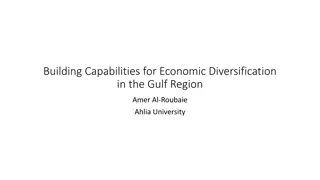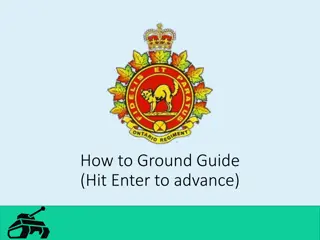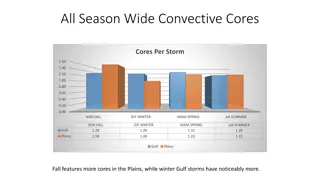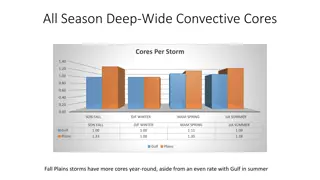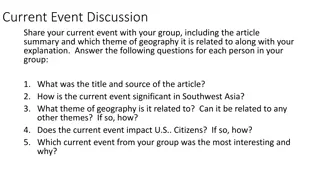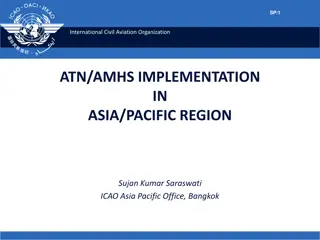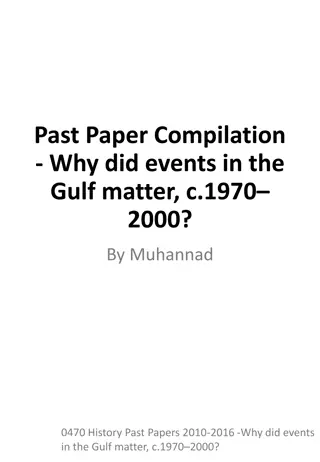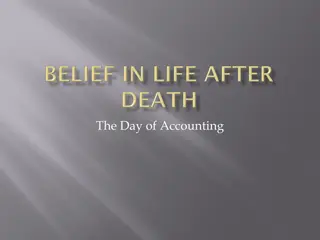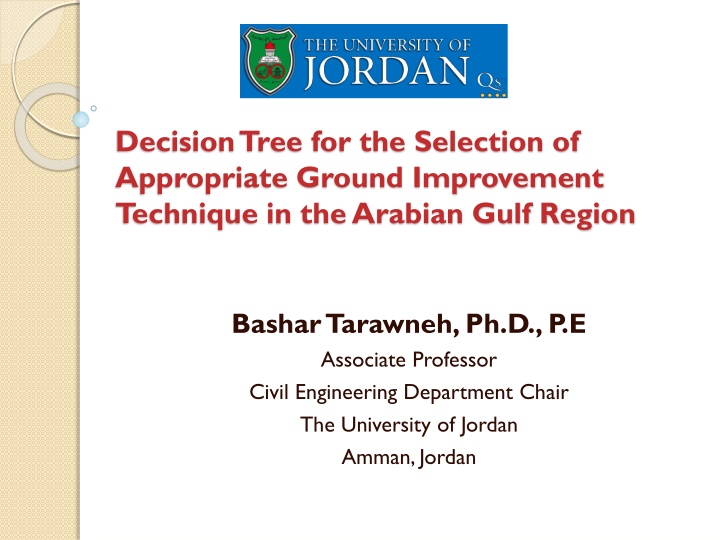
Ground Improvement Techniques in Arabian Gulf Region
Ground improvement is essential in the Arabian Gulf region to enhance soil properties, increase bearing capacity, and mitigate issues like liquefaction and settlements. This article explores popular techniques such as Dynamic Compaction, Dynamic Replacement, Rapid Impact Compaction, Vibro Compaction, and Stone Columns, highlighting their suitability for different soil conditions.
Download Presentation

Please find below an Image/Link to download the presentation.
The content on the website is provided AS IS for your information and personal use only. It may not be sold, licensed, or shared on other websites without obtaining consent from the author. If you encounter any issues during the download, it is possible that the publisher has removed the file from their server.
You are allowed to download the files provided on this website for personal or commercial use, subject to the condition that they are used lawfully. All files are the property of their respective owners.
The content on the website is provided AS IS for your information and personal use only. It may not be sold, licensed, or shared on other websites without obtaining consent from the author.
E N D
Presentation Transcript
Decision Tree for the Selection of Appropriate Ground Improvement Technique in the Arabian Gulf Region Bashar Tarawneh, Ph.D., P.E Associate Professor Civil Engineering Department Chair The University of Jordan Amman, Jordan
Importance of Ground Improvement? Deep foundations is typically more expensive than ground improvement. Problematic soils should be treated before construction to avoid any future damage to structures. Ground improvement is necessary to: Improve soil properties. Increase bearing capacity. Mitigate liquefaction. Reduce potential settlements. I. II. III. Selection of appropriate ground improvement technique is usually a challenge for designer and contractor to meet project requirements. Bashar Tarawneh, Ph.D.,P.E 2
Most popular ground improvement techniques in the Arabian Gulf region Dynamic Compaction (DC) Effective for sandy and granular soils. Can improve soil down to 6 to 9m below ground level. 1. Bashar Tarawneh, Ph.D.,P.E 3
Most popular ground improvement techniques in the Arabian Gulf region Dynamic Replacement (DR) Appropriate for soft saturated fine-grained soils with high fine content. Can reach to a depth of about 7m. 2. Bashar Tarawneh, Ph.D.,P.E 4
Most popular ground improvement techniques in the Arabian Gulf region Rapid Impact Compaction (RIC) Middle-deep compaction method suitable to improve sandy soils where fine content is low. RIC can be employed to densify loose soils down to a depth of about 4 m to 6m. 3. Bashar Tarawneh, Ph.D.,P.E 5
Most popular ground improvement techniques in the Arabian Gulf region Vibro Compaction (VC) Effective for improving the relative density of granular soils with suitable gradations and limited fines contents (not more than 5%). 4. Bashar Tarawneh, Ph.D.,P.E 6
Most popular ground improvement techniques in the Arabian Gulf region Stone Columns (SC) Used for soils with higher fine content. Can be performed near existing structures as it produces less vibration that other techniques. can be formed by inserting a vibratory probe to incorporate the granular soil into the ground and form vertical inclusions. 5. Bashar Tarawneh, Ph.D.,P.E 7
Decision Tree Development Decision tree is considered: Simple but powerful form of multiple variable analysis. It is a graph that uses a branching method to choose between several events. Geotechnical engineer must determine the most appropriate method under specific project conditions. By eliminating incompatible techniques, a Geotechnical engineer can select the most appropriate one from the remaining compatible methods. Data is obtained from 75 completed ground improvement projects in the Arabia Gulf region ( Saudi Arabia, Kuwait, United Arab Emirates, Oman, Qatar, and Bahrain). o o Bashar Tarawneh, Ph.D.,P.E 8
Vibration Assessment *PPV at 5 m away from the work (mm/s) Technique DC 55 DR 39 RIC 20 VC and SC 13 *Peak Particle Velocity Bashar Tarawneh, Ph.D.,P.E 9
Analysis of the Collected Data The statistical significance of the collected variables is verified using analysis of variance ( ANOVA). All collected factors are significant for the selection process except the water table level (WTL). This is because shallow WTL can be mitigated by using a filling platform to carry the equipment. Ground Depth of Distance to Fine Content Water Table Improvement Improvement Nearby (%) Level (m) Technique (m) Structures (m) DC 7-21 4-9 17-75 1.5-6 DR 25-70 2-7 25-100 1-8 SC 20-80 4-19 4-36 0.5-7 RIC 8-16 1-5 12-100 1-8 VC 3-7 8-19 7-50 1-5 Bashar Tarawneh, Ph.D.,P.E 10
DECISION TREE If more than one technique is appropriate, cost effectiveness will be employed for the final selection. 11
Conclusions The proposed decision tree can be used to select appropriate ground improvement method. If two methods are appropriate, then cost- effectiveness must be employed for the final selection. Distance to nearby structures is the most important factor because some of the techniques cannot be utilized due to the existence of nearby structures even though they are efficient and cost-effective. Bashar Tarawneh, Ph.D.,P.E 12
Conclusions All collected factors are significant for the selection process except the water table level (WTL). This is because shallow WTL can be mitigated by using a filling platform to carry the equipment. DC and DR can cause damage to nearby structures because they produce the highest PPV and must be used in rural areas. Bashar Tarawneh, Ph.D.,P.E 13
Conclusions SC and VC produce the least PPV and can be used in urban areas. RIC produce PPV less than DC and DR but more than VC and SC. However, RIC can be used in urban areas with caution. Bashar Tarawneh, Ph.D.,P.E 14
THANK YOU Bashar Tarawneh, Ph.D.,P.E 15






